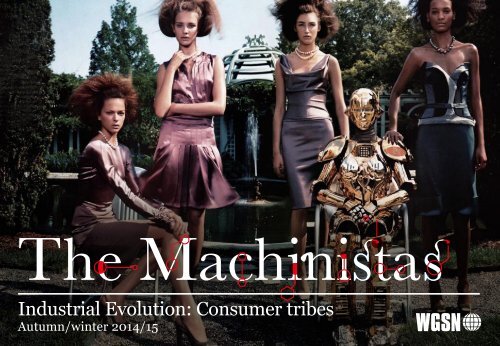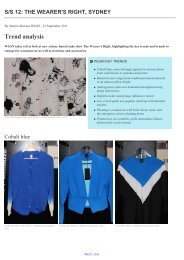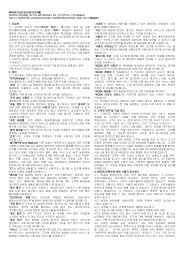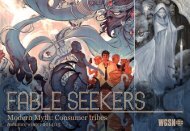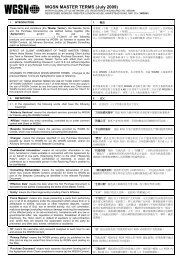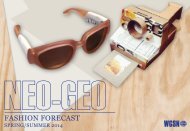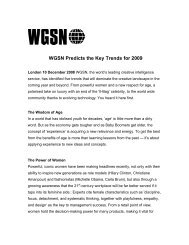Industrial Evolution: Consumer tribes - WGSN
Industrial Evolution: Consumer tribes - WGSN
Industrial Evolution: Consumer tribes - WGSN
You also want an ePaper? Increase the reach of your titles
YUMPU automatically turns print PDFs into web optimized ePapers that Google loves.
<strong>Industrial</strong> <strong>Evolution</strong>: <strong>Consumer</strong> <strong>tribes</strong><br />
Autumn/winter 2014/15
<strong>Industrial</strong> <strong>Evolution</strong><br />
As our relationship with machines change, we will become<br />
different types of consumers and workers. The Machinistas - the<br />
<strong>Industrial</strong> <strong>Evolution</strong> tribe - will invent new roles for themselves in<br />
the workplace. They are energetic entrepreneurs, always<br />
experimenting with new ideas and embracing technology.
Research & Reference<br />
Small-scale factory owners<br />
BMFF - best machine<br />
friends forever<br />
Transhuman<br />
DIY digital<br />
Bedroom bio-tech<br />
Time on our hands
Small-scale factory owners<br />
New machines and robots will allow for small-scale production.<br />
A new robot from Rethink Robotics called Baxter makes it possible for small-scale business owners to use and work alongside robots and thus start up miniature<br />
factories. Unlike previous industrial robots, Baxter can perceive humans working near it and avoid injuring them. This means Baxter does not have to be isolated, but<br />
can be plugged into a wall socket in a person’s garage or other small workspace and can work right next to humans.
Small-scale factory owners<br />
Baxter is also easy to train. And lastly, and perhaps most importantly, Baxter is cheap. “Priced at $22,000, it’s in a different league compared with the $500,000 total<br />
bill of its predecessors. The user can interact with it directly, immediately, without waiting for experts to mediate – and use it for non-serious, even frivolous things. It’s<br />
cheap enough that small-time manufacturers can afford one to package up their wares or custom paint their product or run their 3D printing machine. Or you could<br />
staff up a factory that makes iPhones.” Kevin Kelly. www.wired.com, December 2012
BMFF - best machine friends forever<br />
<strong>Consumer</strong>s will become emotionally connected to their personal robots and machines.<br />
AIDA (Affective Intelligent Driving Assistant) – a collaboration between Volkswagen of America and MIT – not only reads the road; it also reads your mood. The<br />
machine learns a driver’s driving habits and needs by combining behavioural data with real-time feeds from onboard computers and the web. It can text ahead when<br />
you’re running late without you asking, based on your calendar, contacts and traffic conditions, before you have thought of it. It can also advise on your driving if you<br />
are in a bad mood. The future version will have mood detection technology – its expressive blue eyes will chime with your mood, fostering a bond.
BMFF - best machine friends forever<br />
“British designer Dominic Wilcox has created a pair of prototype shoes which offer to guide the wearer home with built-in GPS navigation. The inspiration for the<br />
clever footwear derives from The Wizard of Oz character Dorothy’s red shoes, which famously transported her home with a click of her heels. Naturally, the GPS<br />
system within Wilcox’s shoes is also activated by clicking the heels together…<br />
A GPS unit contained within the heel of the left shoe communicates wirelessly with the right shoe and provides data to the integrated LED lights – which display both<br />
the correct direction home, and how much of the journey still remains.” www.gizmag.com, September 2012
Transhuman<br />
As a growing wave of consumers experiment with machine-like body modifications, prosthetics are becoming ever more acceptable.<br />
“With prosthetic limbs designed to look like a human foot, wearing a shoe is no longer a problem. But the unique shape of the carbon fibre prosthetic blades worn by<br />
athletes obviously can’t accommodate a traditional shoe, so Nike invented a new one.” (Just before London 2012.) Andrew Liszewski, Gizmodo.com<br />
We expect to see a surge in innovative products and para-specific technologies by Rio 2016.
Transhuman<br />
Transhumanism is on the rise.<br />
The cult of the grinder (part human, part machine) has seen people implant magnetic receptors under their skin so they can sense when there is a magnetic field<br />
nearby and how large and strong it is. One man can even sense his wife’s movements within his own body now that she has had a similar chip implanted. A woman<br />
from Aberdeen has enabled herself to unlock her computer through a chip, which she inserted into her finger with the aid of a sharp blade and vodka. And a New York<br />
University arts professor has implanted a camera in the back of his head to create a third eye.
DIY digital<br />
The DIY movement comes of age digitally, as consumers start making things with garage-style printed circuitboards.<br />
“Massimo Banzi helped invent the Arduino, a tiny, easy-to-use open-source microcontroller that's inspired thousands of people around the world to make the coolest<br />
things they can imagine – from toys to satellite gear. Because, as he says, ‘You don't need anyone’s permission to make something great.’” www.ted.com, June 2012
DIY digital<br />
Banzi calls the Arduino “the equivalent of sketching on paper, done with electronics”.<br />
Here are some of the projects – some less commercial than others:<br />
• Students sending satellites into orbit<br />
• A cat feeder that recognises which cat from a chip<br />
• A quadcopter that can transport items from one African village to another<br />
• The Enough Already device that will mute the TV when an overexposed personality is mentioned<br />
• An NYU project which allows handicapped kids to play videogames<br />
• A glove that understands sign language gestures and turns them into sounds and writes the words on a display<br />
• The txtBomber contraption made up of multiple spray cans, which lets you roll a political message on a wall<br />
• Botanicalls, a unit that goes into a planter so the plant can tweet how it feels<br />
• A chair that tweets when somebody sitting on it passes gas<br />
www.3dprinter.net, July 2012
Bedroom bio-tech<br />
A new generation of consumers is combining computer coding with biology in their own home laboratories.<br />
“Cathal Garvey’s goal is to show that biology can be done in an open-source fashion, and on a shoestring budget. Instead of beakers, he uses recycled jars. A steriliser<br />
is rigged from a pressure cooker and a hot plate. To feed his germs, he boils potatoes into a starchy mix. Several DIY biologists have begun making inexpensive<br />
equipment so that more people can participate. CoFactor, a California company, now sells a $599 DNA-copying machine called OpenPCR. Near San Francisco,<br />
there’s now a 2,400sq ft laboratory called BioCurious, where community members can test their molecular-biology skills.” www.technologyreview.com, February 2012
Bedroom bio-tech<br />
“Domesticated biotechnology, once it gets into the hands of housewives and children, will give us an explosion of diversity of new living creatures, rather than the<br />
monoculture crops that the big corporations prefer. New lineages will proliferate to replace those that monoculture farming and deforestation have destroyed.<br />
Designing genomes will be a personal thing, a new art form as creative as painting or sculpture.” Futurist Freeman Dyson. www.nybooks.com, 2007
Time on our hands<br />
The new age of machines will free up people’s time and allow consumers to concentrate on new and different tasks.<br />
“<strong>Industrial</strong>isation did more than just extend the average human lifespan. It led a greater percentage of the population to decide that humans were meant to be ballerinas,<br />
full-time musicians, mathematicians, athletes, fashion designers, yoga masters, fan-fiction authors, and folks with one-of-a kind titles on their business cards.<br />
With the help of our machines, we could take up these roles; but of course, over time, the machines will do these as well. We’ll then be empowered to dream up yet<br />
more answers to the question ‘What should we do?’” Kevin Kelly. www.wired.com, December 2012
Time on our hands<br />
“Robots will do jobs we never imagined even needed to be done. And they will help us discover new jobs for ourselves, new tasks that expand who we are. They will<br />
let us focus on becoming more human than we were.” Kevin Kelly. www.wired.com, December 2012<br />
“That's what makes the SARTRE (Safe Road Trains for the Environment) project so significant – it represents the beginning of a new era where the organised chaos of<br />
individual drivers can be blunted by an autonomous "follow-the-leader" approach that has clear benefits for road safety, congestion and vehicle fuel consumption...<br />
not to mention being a bonus for those of us who would rather read the paper than concentrate on the road ahead.” Noel McKeegan. www.gizmag.com, May 2012
<strong>Industrial</strong> <strong>Evolution</strong><br />
Key takeaways<br />
<strong>Consumer</strong>s are gaining the tools and powers to make their own products.<br />
In line with this, we see:<br />
• The emergence of consumers as small-scale factory owners, making new, tailor-made products<br />
for a local market<br />
• <strong>Consumer</strong>s relying on and becoming friends with machines and robots<br />
• Transhuman consumers who experiment with machine-body modifications and inserts<br />
• <strong>Consumer</strong>s experimenting with digital DIY to make new and fun products<br />
• People pursuing DIY biotechnology in home laboratories<br />
• <strong>Consumer</strong>s liberated by machines to take on a whole new range of jobs and hobbies


